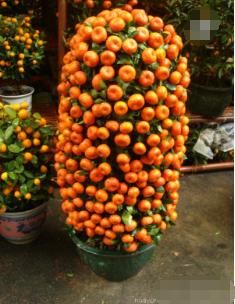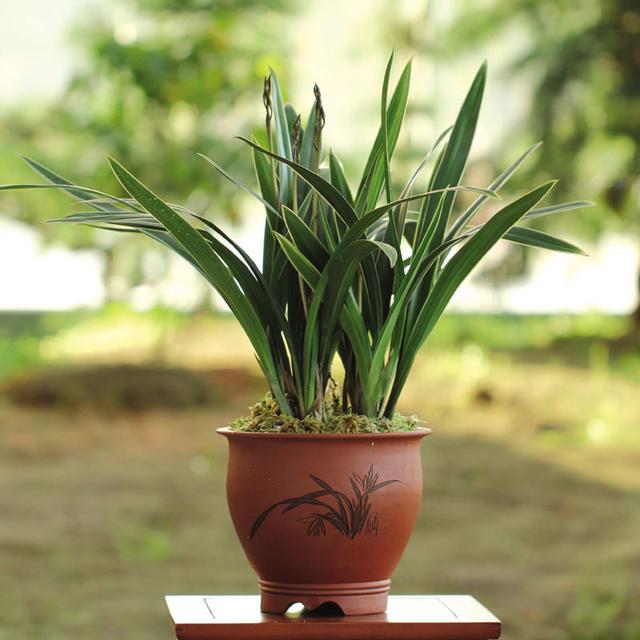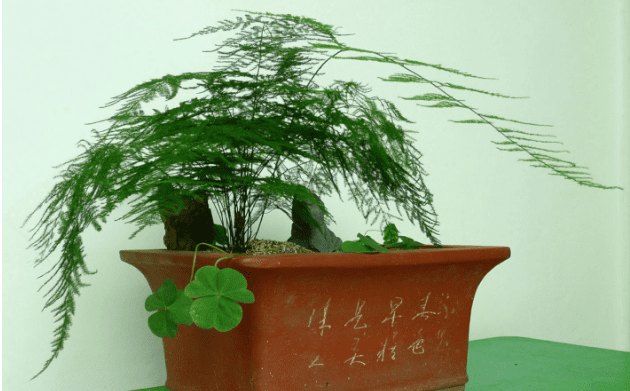How to raise kumquat in winter
How does the family raise kumquat? Looking at the experience of presbyopia farmers, I really benefited a lot.
Kumquat is also called round kumquat. It is warm and slightly cold. It can be planted or potted. Kumquat evergreen, summer flowering, autumn and winter mature, golden fruit, green leaves embellished, especially beautiful, autumn and winter fruit mature or yellow or red, dotted with green leaves, high ornamental value, it is better in winter. It is placed in the hall and living room, adding new ideas and elegance. It is one of the better potted plants in the family.

Seedling cultivation and management potted kumquat is usually used as a rootstock for grafting and propagation. The grafting method was carried out in June and the rootstocks should be planted one year in advance. After grafting, the seedlings propagate asexually, making them grow into plants in the early stage, and can be properly pruned to form a certain tree shape. In general, kumquat surviving this year should be watered once a day or every other day, 4-5 times in summer and autumn, mainly nitrogen fertilizer, appropriate amount of phosphorus and potassium fertilizer. .
Potted kumquat is replaced every 2 to 3 years, preferably from March to April before orange germination. Basins are based on the size of plants. Potted soil should be made of loose, fertile acid loam and can be made by mixing humus soil, compost or horse dung and coarse sand. Keep the old soil when changing the pot, cut off the rotten roots and cut off the thick roots. Note that the new soil does not touch the roots directly, fill the basin with water, keep the soil moist, and no sunlight can be seen for 10 days.
After the plant resumes growth, normal management should be carried out to prevent kumquat branch growth in summer, promote tree nutrient accumulation, form flower buds, "reduce water" before heat, and gradually reduce watering heat 10 days ago. Stop watering 5 days before heating. To prevent the leaves from dehydrating, spray the leaves with water in the morning and evening and spray a small amount of water. When most axillary buds change from green to white, the axillary buds will expand from green to white. Restore the water supply in time.
Pruning in order to make the family potted kumquat crown uniform and beautiful, promote the sprouting of thick branches, cultivate the robust fruit of mother branches, and need to be shaped in the process of growth. Generally speaking, three spring buds will be cleared after germination in spring, and weak or overdense buds will be removed in summer and early autumn from June to August. Buds sent after mid-August should be completely deleted. During the flowering and fruiting period, special attention should be paid to thinning fruit, increasing fruit setting rate, and preserving fruit on all sides of potted orange to improve ornamental value. After the fruit is harvested in winter, all the fruit can be taken out between the end of March and the beginning of April, and the fruit can be cut again during the Spring Equinox's visit to the green.
How does potted kumquat grow more? A method for treating potted kumquat
In the new year, we often see many friends raise kumquats at home. In fact, it has a meaning of good luck. Kumquat is very fragrant when it blossoms. When the fruit is ripe, it can be covered with branches. Whether it is ornamental flowers or fruits, potted kumquat has a certain ornamental value. So how do you grow potted kumquat to make it more effective? How can we keep it in our daily life? Then follow the editor.
Kumquat
How to plant potted kumquat to make it more fruitful?
Reasonable pruning. After spring, when the temperature rises, kumquats grow faster and must be pruned. In other words, keep the branches with a round crown as needed, select 3-5 main branches to stay on the trunk, and cut off other excess trunks and bases. Then, according to the strength of the remaining backbone, shortcuts, strong branches can leave 4-5 bud cuts; weak branches can leave 2-3 bud cuts. In this way, the growth of branches can be regulated, the strong spring branches of each main branch can be promoted, and the material foundation for flowering can be laid. After two months of growth, the new buds are roughly flush. In order to control it for too long, it needs a good pruning. However, the amount of trimming can be reduced, mainly based on shearing. In the future, when new buds have eight leaves, they should be topped once. The aim is to induce a large number of summer bamboo shoots to achieve more flowering and fruiting. The later picking of the heart is determined by the fact that summer buds can form buds.
How do we keep potted kumquat in our daily life?
(1) rational fertilization and "water intake". Kumquat is suitable for fertile, loose, acidic sandy loam. When filling, it is recommended to use 4 parts of humus soil, 5 parts of sand and 1 part of cake fertilizer to prepare the culture soil. After a good pruning, decomposed organic manure (such as human excrement, green manure, bean cake, fish oil, etc.) should be applied, and then applied every 10 days. At this time, the temperature is suitable and the fertilizer is sufficient, which is beneficial to many spring branches. When the new buds are washed, after picking the heart, quick-acting phosphate fertilizers (potassium dihydrogen phosphate, calcium superphosphate) must be used to promote flower bud formation. The key to the formation of flower buds is that the nutrients stored in kumquat will not be consumed in the process of excessive branch and leaf growth, but in the reproductive development of flower bud differentiation. Buckling water can also promote flower bud differentiation. As the saying goes, "dried flowers and wet fruits" refers to the need for appropriate watering during the flower bud differentiation period. This is "fetching water". In flower cultivation, water reduction is usually used to inhibit plant growth and promote flower bud differentiation. Specifically, in order to control the growth of branches in summer, kumquat gradually decreased watering for more than ten days before heating, which was beneficial to the formation of flower buds. Stop watering about 5 days before the summer festival. After exposure to sunlight for 3-4 days, the upper leaves of kumquat showed slight wilting and and drooping, and the potted soil was grayish white. However, in order to prevent the film from slightly withering and excessive dehydration, a small amount of water should be sprayed on the leaves in the morning and evening, and the water can be poured into the basin at noon; when the main buds and front buds of kumquat expand, green when white, indicating that flower bud differentiation has been completed. At this time, it is necessary to restore the amount of water in time and apply fertilizer, which will blossom soon.
Kumquat
(2) keeping fresh, keeping fresh and yellowing. Potted kumquats often produce fallen flowers and fruits. If it is rainy during flowering, moisture is overcontrolled, or when new buds are taken out, fertilizer is in short supply, high temperature can easily lead to falling flowers and fruit. Therefore, the management of fruit period should be done well. Before and after flowering, in addition to the correct management of fertilizer and water, water should be sprayed on the leaves in the afternoon and evening. If new buds are found, they should be removed in time. When flowering, appropriate flowering should be used to save nutrition. After washing China, 0.3% color 0.4% urea or 0.3% compound fertilizer can be sprayed, and 15ppm's 2mi 4murD can be added. This has a significant effect on the fresh-keeping fruit of potted kumquat. After the young fruit is born, when the young fruit grows to 1 cm, it is necessary to thin the fruit. Usually, it is appropriate to leave 2-3 fruits per branch. In the same petiole, sometimes 2-3 young fruits can be produced, only one can be selected, and the whole plant fruit is evenly distributed. In the future, it is necessary to cut off autumn branches in time, instead of achieving good results, so that the fruit develops well-the shape and maturity of the fruit are consistent, and the ornamental value is improved.
Under normal circumstances, the fruit gradually turns yellow after winter. In order to enjoy the Spring Festival, if the fruit ripens earlier, shading and nitrogen fertilizer (0.4% urea) can be used to delay ripening. If the fruit ripens later, the Spring Festival is not as good as yellowing. It can be administered with 1500ppm ethephon or 25-50ppm gibberellin 25 days before maturity.
Kumquat
The above is the knowledge introduction about potted kumquat. Potted kumquat should be placed in a sunny place and should be pruned to promote the growth of new buds. Kumquat is a fertile crop. In the process of planting, fertilizer is often applied to maintain moisture, which is beneficial to its growth. The editor warned that a large amount of water should not be poured during the flowering and fruiting of kumquat. The fruit must be stabilized before it is watered properly.
Cultivation methods of kumquat tree to improve kumquat tree
In life, many people buy kumquat trees at home as ornamental green plants and ornaments. The fruit of the kumquat tree is golden yellow, which is also a good decoration. It tastes sweet and sour, and the kumquat trees in the south are often warm. It is used as a fruit tree. So how is the kumquat tree cultivated? Is there any good breeding method? The following is a brief introduction to the planting methods of kumquat trees.
First, better planting environment and time
Kumquat trees can be planted in spring, summer and autumn, but the best season for planting is autumn, and the general survival rate can be as high as 90%. The growth rate of the kumquat tree is about to water the plant once or twice a day. We need to adjust the amount of water according to the change of weather temperature. The better growth temperature of kumquat is 24 to 28 degrees Celsius. For the requirement of growing light, the kumquat tree is cleaned in summer, and when there is plenty of light, we should put it in a dark hiding place.
Second, better breeding
For the cultivation method of kumquat tree, there are some requirements for watering. It is forbidden to spray water during flowering to prevent kumquat trees from being exposed to rain during flowering. At the same time, make sure that the flowers are fresh and sweet to prevent the kumquat from blooming. Fester to ensure the normal pollination of the golden orange tree. In fertilization, we must ensure that the fertilizer concentration should not be too high every 8 to 10 days. During the bud period, enough phosphate fertilizer should be applied to ensure that the fruit is full and full. For the local people, we must ensure that when the nutrients in the potted soil are absorbed by the golden orange tree, the potted soil is replaced and the new nutritious soil is replaced in about two to three years. At the same time, remove some dead branches and old stems around the soil pot, stir the organic fertilizer and nutritious soil evenly at the bottom, and then add the surrounding fertile soil and water.
Third, the main points of kumquat tree pruning
Generally speaking, when the kumquat tree is young, we should use the "light cut" pruning method. We usually only subtract those long and dead branches to ensure that young kumquat trees have an adequate supply of nutrients.
2, the kumquat tree enters, and when the fruit is more prosperous, we can cut off all the leaves and leaves that have lost the ability to restore the kumquat tree to flourish. For a branch or two or three treetops at one end, you can choose the "strong or weak" pruning method to ensure that strong branches produce enough full fruit.
We can cut off soft wooden branches when it is cold in winter. The kumquat tree has some long branches. For these long branches, they will not only disturb the shape of the tree, but also hinder the growth and fruiting of other branches. We can choose to cut off all the parts that do not have or hinder the growth of other branches, so as not to be nutritious and unfruitful.
The above is the relevant content of the golden orange tree farming method introduced for everyone. Kumquat is a good ornamental fruit tree. Its value is very high, reasonable planting can ensure the robust growth and good appearance of the golden orange tree. You can refer to some of the agricultural techniques described in this article for specific reference. I believe everyone can plant a golden and fruity kumquat tree.
Time: 2019-05-14 Click:
- Prev

What if the leaves of Jianlan turn yellow?
What should I do if Moran's leaves are yellow? The plant of Molan is a small potted plant. The ornamental value is very high, and it is said to purify the environment, so it is very suitable for us to grow at home or in the office. However, a friend who grew up said
- Next

How to maintain asparagus in winter
Asparagus is such a beautiful plant in four seasons. This small potted plant is very suitable for indoor breeding. This is a very beautiful view in the living room or study. Breeding it at home has many advantages. Its maintenance is very important in winter.
Related
- Fuxing push coffee new agricultural production and marketing class: lack of small-scale processing plants
- Jujube rice field leisure farm deep ploughing Yilan for five years to create a space for organic food and play
- Nongyu Farm-A trial of organic papaya for brave women with advanced technology
- Four points for attention in the prevention and control of diseases and insect pests of edible fungi
- How to add nutrient solution to Edible Fungi
- Is there any good way to control edible fungus mites?
- Open Inoculation Technology of Edible Fungi
- Is there any clever way to use fertilizer for edible fungus in winter?
- What agents are used to kill the pathogens of edible fungi in the mushroom shed?
- Rapid drying of Edible Fungi

